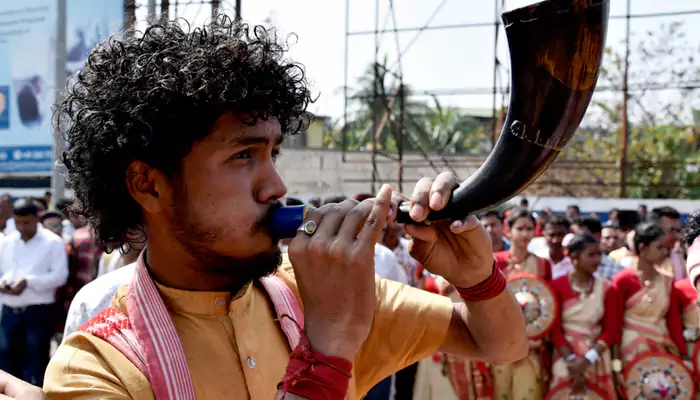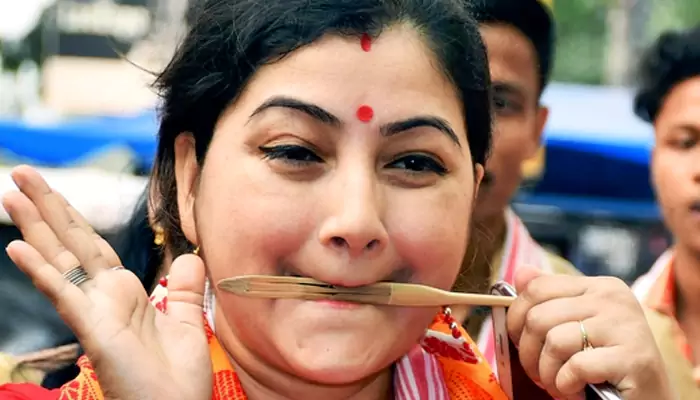
When spring dances in Assam, the air hums with the lively tunes of Bihu. Let’s meet the instruments that make this music so magical!
There’s something about Bihu music that just makes you want to move. Maybe it’s the rhythmic beats, the playful melodies, or the way it perfectly captures the joy of spring. But behind every foot-tapping Bihu song are some incredible traditional instruments—each with its own personality and role.
So, let’s take a closer look at the stars of Bihu music—the instruments that turn a simple tune into a celebration of life, love, and new beginnings.

If Bihu music had a pulse, it would be the dhol. This double-headed drum is the backbone of every Bihu performance, setting the rhythm that dancers and singers follow.
Made from wood and animal hide, the dhol is played with sticks—one thick, one thin—creating deep, resonant beats that can be heard from a distance. The sound is infectious, and once it starts, you’ll see people tapping their feet almost without realizing it.
Fun fact: A skilled dhol player can change the pitch by tightening or loosening the straps, adding a dynamic touch to the music.

Ever heard that sharp, reedy sound in Bihu songs that feels like a call to celebration? That’s the pepa, a traditional horn made from buffalo horn and bamboo.
Blowing into the pepa takes serious lung power, but the result is a bright, piercing tone that cuts through the music, giving it that unmistakable Bihu energy. Originally used by herdsmen, it’s now a signature sound of the festival.
And here’s a cool detail—some pepas are decorated with colorful tassels, swaying as the musician plays, adding a visual flair to the performance.

Don’t let its small size fool you—the gogona packs a unique, twangy sound that’s impossible to ignore. This bamboo instrument is held between the teeth and plucked to create a vibrating, jaw-harp-like effect.
It’s tricky to master, but when played right, it adds a playful, buzzing layer to Bihu music. Some say its sound mimics the buzzing of bees, fitting perfectly with spring’s lively vibe.
(Credit- dhuniya_axom_)
Simple yet essential, the toka is a pair of bamboo clappers that keep the rhythm crisp and tight. Held in one hand, it produces a sharp, clicking sound that complements the dhol’s deeper beats.
What’s fascinating is how versatile it is—some musicians flip it mid-performance to vary the sound, adding little surprises to the rhythm.
(Credit- _kumkumborah_)
This one’s a bit of a hidden gem. The xutuli is a clay or bamboo whistle that mimics birdsong, blending seamlessly into Bihu’s nature-inspired tunes. Its soft, flute-like tones often weave through faster melodies, adding a touch of serenity.
It’s not as loud as the pepa or as dominant as the dhol, but it brings a sweet, earthy quality to the music—like the whisper of the wind in spring.
(Credit- bitupan_m007)
No traditional Assamese music is complete without the baanhi (bamboo flute). With its mellow, flowing notes, it adds depth and emotion to Bihu songs, especially the slower, more reflective ones.
Skilled players can make it sing—sometimes joyful, sometimes wistful—but always beautiful. It’s the instrument that reminds us that Bihu isn’t just about dance and energy; it’s also about stories and feelings.
Bihu music isn’t just sound—it’s a feeling. And these instruments, each with its own character, come together to create something truly special. The dhol’s thunder, the pepa’s cry, the gogona’s buzz, the toka’s snap, the xutuli’s whisper, and the baanhi’s song—they all blend into the soundtrack of spring in Assam.
Next time you hear a Bihu tune, listen closely. You’ll start picking out these instruments, and suddenly, the music becomes even more alive.